
The Little River and Calabash areas offer great redfishing opportunities for anglers from both Carolinas.
The rod jerked hard as something grabbed the live shrimp on the end of Capt. Mark Dickson’s line. He reared back to set the hook, and the rod bent deeply as his small spinning reel began singing a happy song. A wake appeared as a hooked redfish surged down the bank in the shallow creek near the North Carolina/South Carolina state line.
With a bent rod and singing reel in his hand, a broad smile spread across Dickson’s face.
“I thought these fish might regroup if we gave them a little time and didn’t disturb them too quickly,” said Dickson, who operates Shallow Minded Guide Service in Myrtle Beach. “They’ve been feeding a little farther down the creek, and I didn’t think we were close enough yet to spook them, but they must have moved. ”
A few minutes later, Dickson led the tired fish to the landing net. Capt. Mark Stacy, his partner, leaned out a bit and scooped it up. It was a nice red drum, at the upper end of or slightly over North Carolina’s 18- to 27-inch slot limit, and well beyond South Carolina’s 15- to 23-inch slot. Measurements didn’t matter, as the fish was destined to be released anyway.
Stacy lofted an easy cast up near the bank about 10 yards from where Dickson had hooked the first fish. As Dickson paused to look, Stacy’s rod bounced, and he leaned back into a hookset. Now it was Stacy with a bent rod and singing reel and a big smile spreading across his face.
“Wow,” Stacy said. “This is fun. It’s not often you get two strong hookups on back-to-back casts. I’m glad we decided to come fishing today and to check this creek out. I expect we’ll be coming back here several more times during the summer.”
About 45 minutes and about a dozen redfish later, Dickson said the tide was high enough to get through one of the creeks he wanted to check. After a ride of only a few minutes, he made a wide swoop in the Intracoastal Waterway, cut off the outboard and glided into the mouth of a creek with large oyster rocks on each side.
Dickson’s advice was to begin fishing a foot or so off the oysters. Stacy slipped the hook up through the head and horn of a shrimp and dropped it just off an indentation in the oyster rock. Dickson started to comment on the near-perfect cast but was interrupted by Stacy setting the hook and calling out his strike.
“I really like this creek,” Dickson said. “During the winter, I fish it at the last of the falling tide, through the low and back into the first part of the rise. During the summer, I use my larger boat, so I wait for the tide to begin rising and work my way back in with the fish. If they are still out here at the mouth, our timing is about right.”
Stacy worked his tiring red and popped the hook free. Dickson was it was likely one of the fish the S.C. Department of Natural Resources releases into Dunn Sound, being about the right size to have been from one of the last several releases.
Redfish came from the edges of several oyster rocks and smaller creek mouths as Dickson eased the boat around and through the creek. After a while, he said the tide was about right to try a dock for some larger fish before calling it an afternoon.
Connecting through a maze of creeks, Dickson turned out into the channel to Little River Inlet and paused for a minute. “There are probably some larger reds out by the (Little River Inlet) jetties, but there will be a bit of a crowd, and the boat traffic will keep us rocking,” Dickson said. “Let’s ease up here and fish the shade of a couple of docks and see who’s home.”
Once again, Stacy lofted his first cast perfectly, just inside the shadow line beside the dock. This time, Dickson was able to get baited and make a cast before Stacy was hanging onto a bent rod and singing reel.
“Turn him away from the pilings,” Dickson said. “If he gets in there, you probably won’t get him out.”
Dickson was interrupted by a tug on his line that created his own sense of urgency. The fish was stubborn, but after a few minutes, he managed to turn it away from the dock and its barnacle-encrusted pilings. He breathed a sigh of relief, boating his fish at the same time Stacy was winning his battle. Both fish were well above the 23-inch slot maximum for the South Carolina waters they were fishing, so it seemed like a good time to call it a day.
Dickson and Stacy had crossed the border between the two Carolinas several times, with Dickson pointing out boundary markers at different times and noting that healthy, hungry redfish were present on both sides. A good population of redfish inhabits the entire length of the coastline between Ocean Isle, N.C., and North Myrtle Beach, S.C., but the border reds don’t always recognize the boundary — giving fishermen from both states great opportunities to have the kind of day that Dickson and Stacy had.


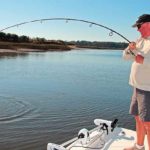
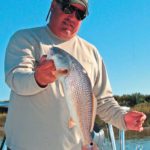
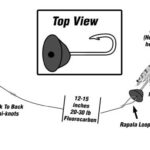
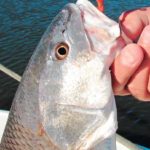
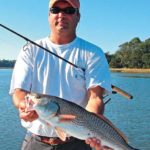
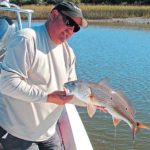



Be the first to comment